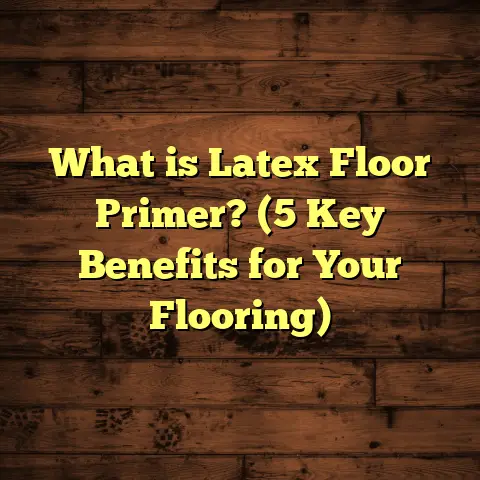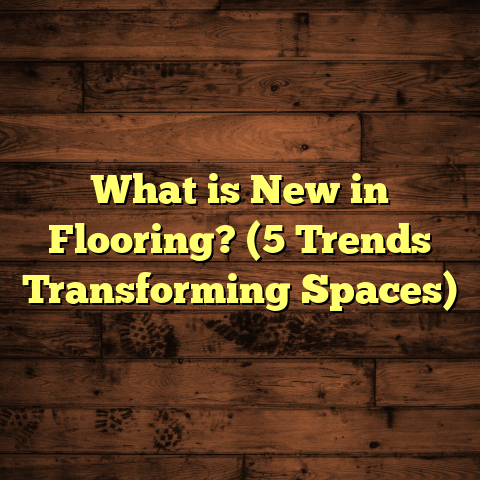What is Hardwood Flooring? (5 Essential Benefits Explained)
I’ve always enjoyed spending weekends working on small projects around my home—whether it’s fixing up furniture or experimenting with new decor styles. One thing I learned quickly is how much the flooring can change the whole vibe of a room. That’s why I got really curious about hardwood flooring. It’s been a game-changer for me, and I want to share what I’ve discovered about it, including some benefits that might surprise you.
What is Hardwood Flooring?
At its core, hardwood flooring is exactly what it sounds like—flooring made from solid wood. Unlike laminate or vinyl, which mimic the look of wood, hardwood floors are crafted from real trees. The planks are typically cut from hardwood species like oak, maple, cherry, or walnut. These woods are chosen because they’re dense and durable, which makes them great for floors that need to handle daily foot traffic.
I remember when I first started considering hardwood for my living room. I wanted something natural and long-lasting, and hardwood fit the bill perfectly. The solid wood is milled into planks that can be sanded and refinished multiple times, which means the floor can literally last decades if taken care of right.
There’s also engineered hardwood, which I experimented with in my kitchen remodel. It has a thin layer of real wood on top but is made with layers of plywood underneath for stability. This option handles moisture better than solid hardwood but still gives you that authentic wood look. I’ll talk more about this later when we compare options.
The Origins and Craftsmanship Behind Hardwood Flooring
Hardwood flooring isn’t just about cutting trees into planks. The process combines centuries-old craftsmanship with modern technology. After harvesting, logs are milled into boards, then dried carefully to reduce moisture content — which matters a lot because wood expands and contracts with humidity.
A few years ago, I visited a local sawmill to see this process firsthand. Watching the raw logs turn into smooth planks was fascinating. The drying phase took weeks, but it’s essential to prevent warping later. Then the planks are sanded, sometimes stained, and finished with protective coats.
The finish on hardwood floors is a big deal too. I learned the hard way that not all finishes are created equal. Some floors have a polyurethane finish that offers strong protection but can feel plasticky underfoot. Others use oil-based finishes that soak into the wood and highlight its natural beauty but require more upkeep.
Comparing Hardwood Flooring Options
When I was choosing flooring for different rooms, I tried a few types: solid hardwood, engineered hardwood, and laminate. Each has pros and cons depending on where you plan to install it and your budget.
Solid Hardwood: This is the classic choice. It’s 100% real wood all the way through. It can be sanded and refinished many times, which really extends its life. However, it’s sensitive to moisture and temperature changes, so it’s not ideal for basements or bathrooms.
For example, in my living room—which gets moderate humidity—I went with solid oak because I wanted durability and a natural feel. The solid planks give off warmth you can’t quite replicate with synthetic materials.
Engineered Hardwood: This has a real wood veneer but plywood layers underneath. It’s more stable when exposed to humidity and temperature changes, so it works well in kitchens and basements. It can be refinished a few times but not as many as solid hardwood.
In my kitchen remodel, where steam and spills are common, engineered hardwood was my go-to. It gave me the look of real wood without worrying about warping or cupping.
Laminate Flooring: This is a synthetic product that mimics the look of wood but isn’t made from real wood at all. It’s more scratch-resistant and easier to install but doesn’t have the warmth or longevity of hardwood.
When I installed laminate in my basement rec room as a budget-friendly alternative, I noticed it was less comfortable underfoot and lacked the character of natural wood. But for high-traffic or kid-friendly spaces where spills were frequent, it held up pretty well.
Species of Hardwood: How Wood Type Affects Your Floor
There are tons of wood species used for hardwood floors, each offering unique looks and performance traits.
- Oak: The most popular choice in the U.S., oak is hard, durable, and has a prominent grain pattern. It’s versatile and stains well.
- Maple: Lighter color with a subtle grain pattern; slightly harder than oak but less forgiving of dents.
- Cherry: Rich reddish tone that darkens over time; softer than oak, so it scratches more easily.
- Walnut: Darker wood with beautiful swirls; softer than maple or oak but prized for aesthetics.
- Hickory: Extremely hard with dramatic grain variations; great for rustic looks.
When I was selecting wood for my living room floor, I went with white oak because it strikes a good balance between hardness and beauty. My friend chose walnut for her dining room for that deep chocolate tone.
Plank Width and Pattern Choices
Did you know plank width changes how your floor looks? Narrow strips create a traditional feel, while wider planks give rooms a more modern, spacious vibe.
I used 5-inch wide planks in my house for a classic look but recently saw 7-inch planks in a friend’s loft that made the space feel so open and airy.
Patterns also make a difference—straight planks are standard but herringbone or chevron patterns add visual interest and sophistication.
The 5 Benefits of Hardwood Flooring I’ve Experienced
1. Longevity That Pays Off
One of the best things about hardwood flooring is how long it lasts. My parents installed solid oak floors in their home over 40 years ago, and they still look great today. That durability means you don’t have to replace your floors every few years like you might with carpet or laminate.
According to research from the National Wood Flooring Association (NWFA), hardwood floors can last anywhere from 25 to 100 years depending on the species and maintenance. That’s pretty incredible when you think about it.
Plus, because you can sand and refinish hardwood floors multiple times, you can remove scratches or dents without having to rip everything out. When I refinished my own floors last year, it felt like getting a brand new surface without the cost of full replacement.
To give you some perspective: Sanding and refinishing costs roughly $3–$5 per square foot but can restore your floor to near-new condition. Replacing carpet or vinyl might cost less upfront but needs replacing every 10–15 years on average.
When I refinished my floors after years of wear and tear—including scratches from moving furniture and pet nails—it brought back their shine effortlessly.
2. Adds Real Value to Your Home
Hardwood floors are often cited by real estate experts as one of the best investments for increasing home value. Homes with hardwood flooring tend to sell faster and for more money compared to those with carpet or vinyl.
In fact, a 2023 report by Remodeling Magazine showed that homeowners recoup around 70-80% of their hardwood floor installation costs when selling their homes. That’s a strong return compared to other upgrades.
When I sold my first house, the buyer immediately commented on how much they loved the hardwood floors—it definitely helped make the sale smoother.
A study by Zillow found that homes with hardwood floors sold for an average of 1.5% higher than comparable homes without them—equating to thousands of dollars depending on your market.
This makes sense because hardwood floors are seen as durable, stylish, and easier to maintain than carpet—a big plus for many buyers.
3. Naturally Hypoallergenic Choice
If you or your family suffer from allergies, hardwood flooring might be a smart choice. Unlike carpet, which traps dust mites, pet dander, and pollen, hardwood floors don’t hold onto allergens as much.
Studies show that homes with hard surface flooring like wood have fewer allergens floating in the air compared to homes with wall-to-wall carpeting. My wife suffers from mild allergies, so switching to hardwood made a noticeable difference in air quality at home.
It’s much easier to keep clean too—just regular sweeping and occasional mopping keeps dust at bay.
One interesting fact: The Asthma and Allergy Foundation of America recommends hard surface flooring like wood or tile for allergy sufferers because they don’t harbor allergens like carpet does.
I remember when we had guests with asthma over; they remarked how fresh our home felt compared to their usual carpeted environments.
4. Versatility in Design and Style
One thing I love about hardwood is how versatile it is for interior design. Whether your style is rustic farmhouse or modern minimalist, there’s a wood type and finish that fits perfectly.
I’ve played around with different stains—from light natural tones to deep espresso—and each gave the room a completely different feel. Plus, there are tons of plank widths and patterns like herringbone or chevron to choose from.
This versatility means your floor can evolve with your style over time. You can refinish it in a new color if you want a change without replacing everything.
For example, after living with natural oak floors for years, I recently experimented by applying a darker stain on some boards during a partial renovation—it totally changed the room atmosphere without ripping out any flooring.
5. Environmentally Friendly Flooring Option
Since hardwood flooring comes from trees, people often wonder if it’s eco-friendly. The key is sourcing wood responsibly.
I always check if the flooring comes with certifications like FSC (Forest Stewardship Council), which ensures wood is harvested sustainably. Also, hardwood floors last a long time, so they don’t need to be replaced frequently like synthetic options.
According to data from the Environmental Protection Agency (EPA), sustainably managed forests can provide renewable resources without harming ecosystems. Choosing certified hardwood helps support these practices.
Additionally, because hardwood can be refinished many times instead of replaced entirely, it reduces waste compared to other flooring types that end up in landfills more often.
When I sourced materials for my projects, I made sure my supplier provided FSC-certified wood—which gave me peace of mind knowing I wasn’t contributing to deforestation irresponsibly.
Detailed Data Points That Helped Me Decide
Here are a few data points I gathered while researching:
- Average cost per square foot: Solid hardwood runs about $8–$14 including installation; engineered hardwood is slightly cheaper at $6–$12; laminate costs $2–$5.
- Refinishing lifespan: Solid wood can be sanded 4–6 times; engineered wood about 2–3 times.
- Durability rating: Oak scores about 1290 on the Janka hardness scale (measures resistance to denting); maple scores around 1450.
- Allergen reduction: Homes with hardwood have been shown to reduce airborne allergens by up to 50% compared to carpeted homes.
- Resale value increase: Hardwood flooring can add up to 2–5% to a home’s resale price depending on market area.
- Environmental impact: FSC-certified hardwood supports sustainable forestry practices; non-certified can contribute to deforestation.
- Installation timeline: Installing hardwood typically takes 3–7 days depending on size; laminate usually less than 3 days.
- Maintenance cost: Annual maintenance (cleaning + minor touch-ups) averages around $100-$200; refinishing every 10–20 years costs more upfront but adds decades of life.
Knowing these numbers helped me balance what I wanted aesthetically with what worked financially over time.
Installation Insights From My Projects
Installing hardwood isn’t just about laying down boards—there’s prep work involved that can affect your budget and timeline:
- Subfloor condition matters: Before installation, your subfloor must be level and clean. When I attempted DIY installation once without leveling properly, some boards didn’t sit right.
- Acclimation period: Hardwood needs time to acclimate to your home’s temperature/humidity before installation—usually several days. Skipping this step risks warping later.
- Nailing vs floating: Solid hardwood is usually nailed down; engineered can be glued or floated over underlayment.
- Expansion gaps: Wood expands/contracts with humidity changes—installers leave small gaps around edges covered by trim.
I decided early on that professional installation was worth it for my main living areas because mistakes could be costly. For less visible rooms like basements where I used laminate or engineered wood myself, the learning curve was manageable.
Maintenance Tips That Keep Hardwood Floors Looking Great
Owning hardwood means some care—but nothing too complicated:
- Regular sweeping/vacuuming: Keeps grit off surfaces that can scratch floors.
- Damp mopping: Use slightly damp mop with cleaner designed for hardwood—avoid soaking water as it can damage wood.
- Furniture pads: Prevent dents by adding pads under heavy furniture legs.
- Refinishing when needed: Every 10-20 years depending on wear; sanding removes surface scratches.
One weekend after hosting a party where kids accidentally scratched the floor with toys, I grabbed some wood filler and touched up spots myself—small fixes go a long way between major refinishes.
Personal Stories That Shaped My Views
I’ve had some memorable moments related to my flooring choices:
- When our dog was a puppy, he scratched some soft spots on engineered wood in the kitchen. At first, I worried about permanent damage but realized those marks added character—and could be sanded out later.
- Hosting holiday dinners on my oak floors always gets compliments from guests who notice how warm and inviting everything feels.
- During renovations in an old farmhouse nearby, I saw original pine floors over 100 years old still intact—proof that quality wood stands test of time.
These experiences taught me that hardwood isn’t just about looks; it becomes part of your home’s story over time.
How Hardwood Compares To Other Popular Flooring Choices
It’s easy to get overwhelmed by options out there—carpet, tile, vinyl plank… Here’s how hardwood stacks up based on what I’ve tried:
| Feature | Hardwood | Laminate | Carpet | Vinyl Plank | Tile |
|---|---|---|---|---|---|
| Durability | Very high | Moderate | Low | Moderate | Very high |
| Maintenance | Moderate | Low | High | Low | Moderate |
| Allergen-friendly | Yes | Yes | No | Yes | Yes |
| Installation Cost | High | Low | Low | Moderate | High |
| Appearance | Natural & timeless | Good imitation | Cozy but dated | Good imitation | Stylish & cool |
| Longevity | Decades | ~10 years | ~5-10 years | ~10-20 years | Decades |
| Refurbishing | Sand/refinish possible | No | No | No | Grout maintenance only |
When deciding between these options in different rooms of my house, hardwood made sense where style + longevity mattered most (living room), laminate worked in basement playroom (budget + moisture), carpet stayed in bedrooms for softness underfoot but eventually got replaced due to allergies.
My Take on Costs: Budgeting Hardwood Flooring
Hardwood flooring is an investment—not just in money but effort over years—but breaking down costs helped me plan better:
- Material: $4-$10 per sq ft depending on species & grade
- Installation: $3-$6 per sq ft including labor & prep
- Finishing: $1-$3 if not prefinished
- Maintenance: $100-$200/year average
- Refinishing: $3-$5 per sq ft every 10–20 years
For my 500 sq ft living room solid oak project total was around $8k including installation—higher than laminate alternatives but worth it given expected lifespan and resale value boost.
Using online tools like FloorTally helped me get accurate local estimates before committing—which saved surprises later.
Final Thoughts: Your Hardwood Journey
So here we are—after thousands of words! If you’ve read this far maybe you’re thinking about taking the plunge into hardwood flooring yourself or just want more info before deciding.
I hope sharing my personal experiences combined with detailed facts gives you confidence about what makes hardwood special—from its authentic beauty to lasting value and health benefits.
If you have questions about installation tricks, budget planning based on your specific space size or want tips on caring for your floors once installed—I’m here anytime you want to chat!
Have you tried hardwood yet? What was your experience? Or maybe you’re weighing options still? Let me know—I’d love to hear your story too!





